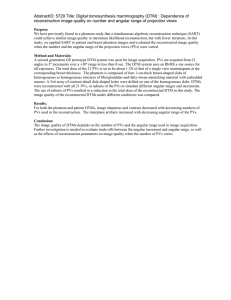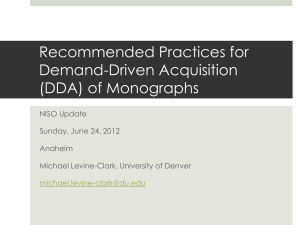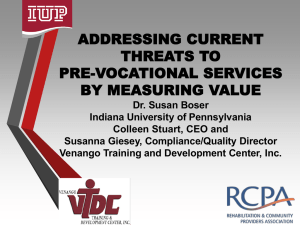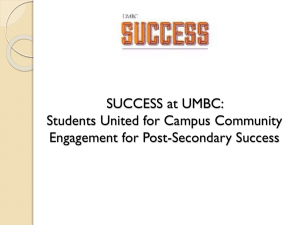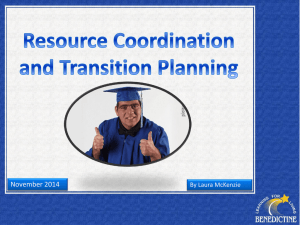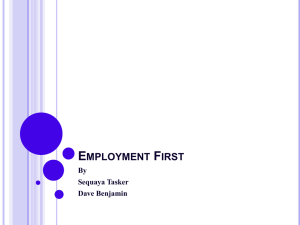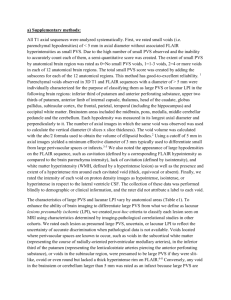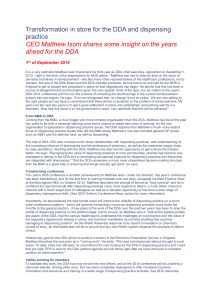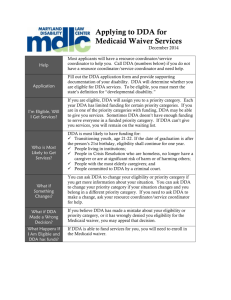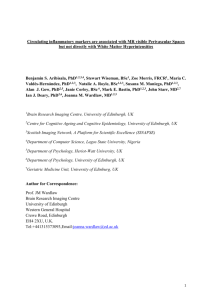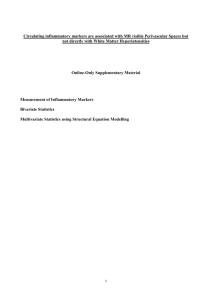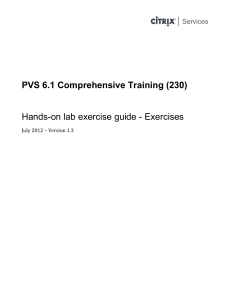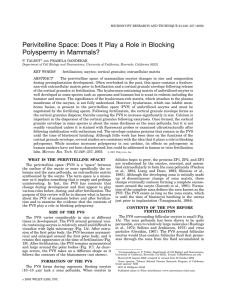Developmental Disabilities Administration (DDA) Pathway to
advertisement
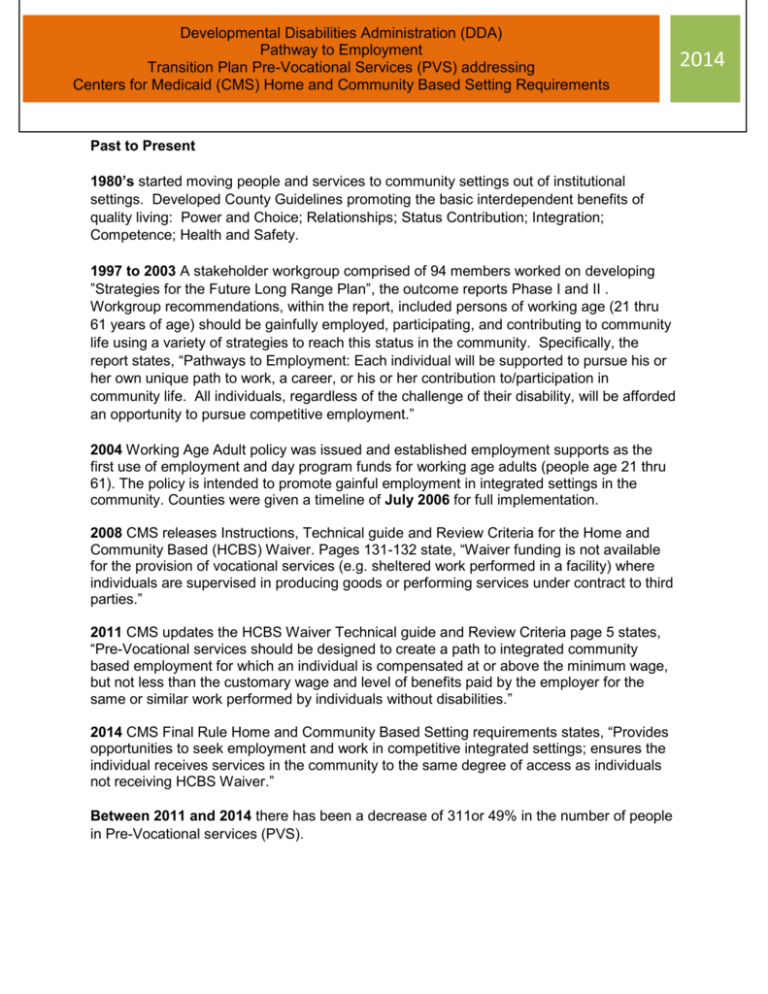
Developmental Disabilities Administration (DDA) Pathway to Employment Transition Plan Pre-Vocational Services (PVS) addressing Centers for Medicaid (CMS) Home and Community Based Setting Requirements Past to Present 1980’s started moving people and services to community settings out of institutional settings. Developed County Guidelines promoting the basic interdependent benefits of quality living: Power and Choice; Relationships; Status Contribution; Integration; Competence; Health and Safety. 1997 to 2003 A stakeholder workgroup comprised of 94 members worked on developing ”Strategies for the Future Long Range Plan”, the outcome reports Phase I and II . Workgroup recommendations, within the report, included persons of working age (21 thru 61 years of age) should be gainfully employed, participating, and contributing to community life using a variety of strategies to reach this status in the community. Specifically, the report states, “Pathways to Employment: Each individual will be supported to pursue his or her own unique path to work, a career, or his or her contribution to/participation in community life. All individuals, regardless of the challenge of their disability, will be afforded an opportunity to pursue competitive employment.” 2004 Working Age Adult policy was issued and established employment supports as the first use of employment and day program funds for working age adults (people age 21 thru 61). The policy is intended to promote gainful employment in integrated settings in the community. Counties were given a timeline of July 2006 for full implementation. 2008 CMS releases Instructions, Technical guide and Review Criteria for the Home and Community Based (HCBS) Waiver. Pages 131-132 state, “Waiver funding is not available for the provision of vocational services (e.g. sheltered work performed in a facility) where individuals are supervised in producing goods or performing services under contract to third parties.” 2011 CMS updates the HCBS Waiver Technical guide and Review Criteria page 5 states, “Pre-Vocational services should be designed to create a path to integrated community based employment for which an individual is compensated at or above the minimum wage, but not less than the customary wage and level of benefits paid by the employer for the same or similar work performed by individuals without disabilities.” 2014 CMS Final Rule Home and Community Based Setting requirements states, “Provides opportunities to seek employment and work in competitive integrated settings; ensures the individual receives services in the community to the same degree of access as individuals not receiving HCBS Waiver.” Between 2011 and 2014 there has been a decrease of 311or 49% in the number of people in Pre-Vocational services (PVS). 2014 Developmental Disabilities Administration (DDA) Pathway to Employment Transition Plan Pre-Vocational Services (PVS) addressing Centers for Medicaid (CMS) Home and Community Based Setting Requirements In 2013 DDA received a grant for Technical Assistance hours from the Office of Disability and Employment Policy (ODEP) to help provider agencies develop transformation plans (a business plan for an agency to move to a fully integrated service model), third party planning, and a variety of provider staff training. Today there are 350 clients receiving Pre-Vocational service in 11 Counties (Asotin, Benton, Franklin, Chelan, King, Pierce, Skagit, Snohomish, Spokane, Whitman, and Yakima) from 15 different service providers. Two of the service providers have transformation plans courtesy of the ODEP grant. Washington defines Pre-Vocational services as part of an individual’s pathway to integrated jobs in typical community employment. These services and supports are intended to be short term and designed to further habilitation goals that will lead to greater opportunities for competitive and integrated employment and career advancement at or above minimum wage. Pre-Vocational services are provided by agencies qualified to deliver services to people with disabilities and offer training and skill development for groups of workers with disabilities in the same setting as well as individual support. Participants are provided the opportunity to experience typical community settings in support of their pursuit to integrated employment at least monthly Transition Plan Over the past couple of years there has been an attrition rate of 100 people in PVS each year. DDA expects all people receiving employment support to be in integrated employment within three years through partnership work and natural attrition unless a shorter timeline is required by CMS. DDA will close the front door to PVS immediately. This means no new persons will enter into PVS so that focus can be given to those currently receiving this service. DDA has asked Counties to work with PVS providers to: Develop agency transformation plans; Assure each person has a solid individualized employment plan; Utilize Individualized Technical Assistance (ITA) as necessary; and Assure accurate outcome data, on the individualized support provided to people to help them move towards their employment goal, is documented and provided. DDA will provide Counties with: PVS outcome data reports on a regular basis; ADSA Web Access training on outcome and billing data; and Any available resources to support: o Agency transformation plans; and o Person Centered Plans 2014
